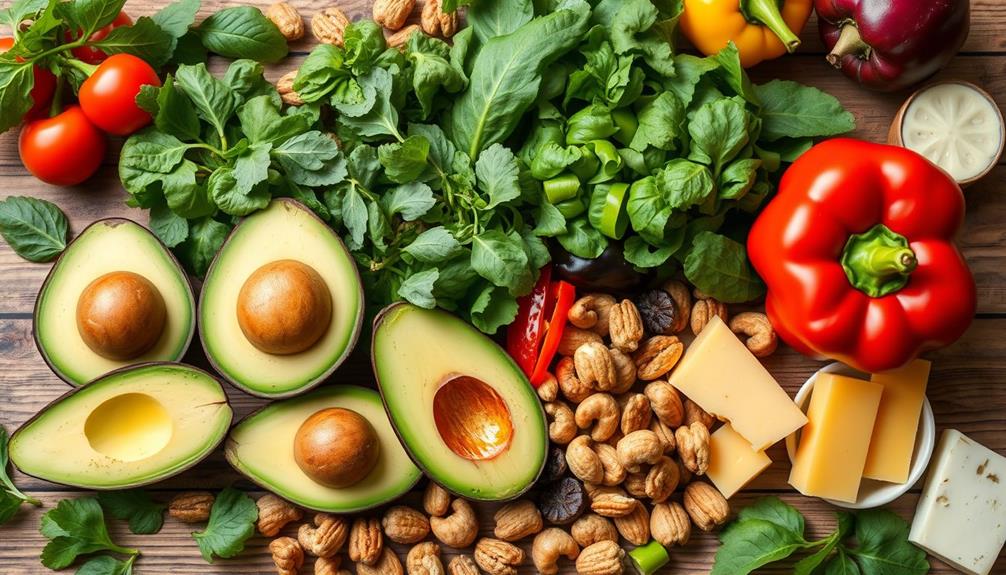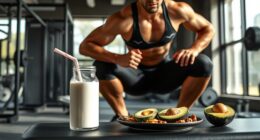To jumpstart your keto diet, drastically cut your carb intake to 20-50 grams per day and boost healthy fats to 70-80% of your caloric intake. Focus on foods like avocados, olive oil, and nuts while eliminating grains and sugary snacks. Include high-quality proteins such as fatty fish and eggs for muscle preservation. Incorporate regular exercise, mixing cardio with strength training to enhance fat burning. Don't forget to monitor your ketone levels with testing methods to verify you're in ketosis. With these steps in mind, you'll set a solid foundation for your keto journey and discover even more helpful tips along the way.
Key Takeaways
- Reduce carbohydrate intake to 20-50 grams per day to initiate ketosis effectively and transition your body to burning fat for energy.
- Increase healthy fat consumption to 70-80% of your daily caloric intake, focusing on sources like avocados, olive oil, and fatty meats.
- Maintain adequate protein intake (0.55-0.77 g/lb of lean body mass) to preserve muscle while adapting to the ketogenic diet.
- Incorporate a mix of aerobic exercise, strength training, and HIIT to enhance fat burning and promote ketone production.
- Regularly monitor your ketone levels using blood tests to ensure effective entry into ketosis and track your progress.
Understanding Ketosis Basics

When you considerably reduce your carbohydrate intake, your body can enter a metabolic state known as ketosis. This typically happens within 2-4 days of limiting carbs to about 20-50 grams per day. In this state, your body shifts from burning glucose to utilizing fat as its primary energy source, which promotes fat burning and weight loss.
The ketogenic diet generally consists of a macronutrient breakdown of 70-80% fat, 10-20% protein, and only 5-10% carbohydrates. To support this fat-burning process, consider incorporating foods rich in antioxidants, such as celery juice, which can aid in digestive health and hydration.
As your liver produces ketone bodies, these compounds become your alternative energy source, leading to increased fat oxidation. However, shifting into ketosis may come with a few challenges. You might experience symptoms often referred to as the "keto flu," which can include fatigue, irritability, and headaches. These symptoms indicate your body is adapting to using fat instead of carbs.
To guarantee you're successfully entering ketosis, regular monitoring of ketone levels through urine strips, breath meters, or blood tests can be helpful. This way, you can track your progress and make necessary adjustments to stay on course with your ketogenic diet.
Key Dietary Adjustments

To kickstart your keto journey, you'll want to increase your healthy fat intake while limiting carbohydrates to under 20-50 grams per day.
Incorporating a balanced diet rich in healthy fats can support your overall health and well-being, aligning with effective strategies for weight loss.
Focus on swapping out high-carb foods for nutrient-rich options like leafy greens and healthy fats from avocados and olive oil.
This balance will help your body shift into ketosis, allowing you to burn fat for fuel more effectively.
Increase Healthy Fats
Increasing healthy fats in your diet is essential for successfully jumping into a keto lifestyle. Aim for 70-80% of your daily caloric intake to come from sources like avocados, olive oil, and coconut oil. These healthy fats are vital for maintaining low carbohydrate levels and achieving ketosis. Incorporating medium-chain triglycerides (MCTs) from coconut oil can further boost ketone production, giving you quick energy.
Here's a helpful table to guide your fat choices:
| High-Fat Options | Benefits |
|---|---|
| Avocado Oil | Rich in monounsaturated fats |
| Coconut Oil (MCTs) | Quick energy source |
| Olive Oil | Heart-healthy polyunsaturated fats |
| Fatty Fish | Omega-3 fatty acids |
Replace low-fat products with full-fat alternatives, like whole-fat dairy and fatty cuts of meat, to enhance your fat intake. Snacking on nuts, seeds, and cheese not only satisfies hunger but also contributes to your overall fat intake. Cooking with healthy oils, such as avocado oil or ghee, elevates your meals while providing essential nutrients. Embrace these high-fat options and kickstart your keto journey effectively!
Limit Carbohydrate Intake
Limiting carbohydrate intake is a crucial step in jumpstarting your keto diet. Aim to keep your daily carb intake between 20-50 grams. This restriction encourages your body to enter ketosis by depleting glycogen stores, shifting your energy source from carbs to fats.
Focus on eliminating high-carb foods like grains, starchy vegetables, and sugary snacks. Instead, replace them with low-carb options such as leafy greens, broccoli, and cauliflower.
It's also important to understand your personal risk tolerance regarding dietary changes, as some individuals may react differently to carb restrictions. Incorporate healthy fats into your meals, aiming for a macronutrient breakdown of 70-80% fat, 10-20% protein, and only 5-10% carbohydrates.
This fat adaptation is essential for a successful low-carb diet. To keep track of your carbohydrate intake, monitor food labels and use apps to spot hidden sugars in processed foods.
If you're new to the keto diet, consider gradually reducing your carbs over a few days. This can ease the adjustment and help minimize symptoms of the "keto flu," such as fatigue and irritability, as your body adapts.
Effective Physical Activity

To maximize the benefits of your keto diet, you need to focus on effective physical activity. Incorporating a mix of aerobic exercises, strength training, and high-intensity interval training won't only boost fat burning but also support your overall health.
Engaging in regular physical activity also helps manage stress levels, which can be beneficial during dietary shifts. Aim for at least 150 minutes of moderate or 75 minutes of high-intensity workouts each week to enhance your adjustment into ketosis, and consider exploring cold medications overview that may support your health during this time.
Types of Exercise
When it comes to jump-starting your keto diet, incorporating the right types of exercise is essential for maximizing fat loss and enhancing your shift into ketosis. Focus on a mix of high-intensity interval training (HIIT), resistance training, and aerobic exercises. HIIT can effectively deplete glycogen stores, promoting fat oxidation and speeding up your adjustment into ketosis.
Resistance training, at least 2-3 times a week, is vital for preserving muscle mass while following a low-carb diet, ensuring your body continues to burn fat for fuel. Aerobic exercises like running or cycling enhance overall fat metabolism and increase ketone production, especially when your glycogen levels are low.
Here's a quick overview of the types of exercise that can benefit your keto journey:
| Type of Exercise | Benefits |
|---|---|
| High-Intensity Interval Training | Promotes fat oxidation and energy expenditure |
| Resistance Training | Preserves muscle mass and boosts insulin sensitivity |
| Aerobic Exercises | Enhances fat metabolism and ketone production |
| Combined Cardio & Strength | Optimizes overall energy expenditure |
Regular physical activity not only aids in reaching ketosis but also helps manage potential side effects, boosting your energy levels and mood.
Frequency and Duration
Finding the right frequency and duration for your workouts can greatly enhance your keto journey. Aim for at least 150 minutes of regular aerobic exercise each week, like running or cycling, to help deplete glycogen stores and accelerate your shift into ketosis.
Incorporating a variety of brewing methods can also keep your energy levels up with delicious low-carb coffee options. Additionally, incorporate strength training 2-3 times a week to boost your muscle mass, which increases your metabolic rate and promotes fat burning for energy.
Consider adding high-intensity interval training (HIIT) to your routine. This can be particularly effective, potentially increasing ketone production and fat oxidation in shorter sessions compared to steady-state cardio.
You might also try fasting workouts, where you exercise in a fasted state. This approach can enhance fat burning and speed up your entry into ketosis, especially when combined with a low-carb diet.
Consistency is vital. Regular exercise not only supports your ketosis but also helps maintain your energy levels and improve your overall health during this dietary shift.
Benefits of Movement
Regular physical activity plays an essential role in your keto journey, offering numerous benefits that enhance your overall experience. Engaging in movement helps deplete glycogen stores, prompting your body to switch to fat as its primary energy source, which is vital for entering ketosis more quickly.
Incorporating aerobic exercises like running or cycling, along with strength training, can boost fat burning and elevate your ketone levels when glycogen is low. As the demand for AI ethicist jobs increases, understanding the importance of ethical considerations in health technology can further enrich your approach to wellness.
High-intensity interval training (HIIT) can further accelerate your shift into ketosis, maximizing calorie burn in a shorter timeframe. While the ketogenic diet might initially affect your exercise performance, regular movement can improve your energy levels and overall adaptation to the diet over time.
Moreover, consistent physical activity supports your metabolic health and can help mitigate potential side effects of the "keto flu." By enhancing your mood and reducing fatigue, exercise makes your keto journey more enjoyable and sustainable.
Importance of Protein Intake

Protein intake plays an essential role in the success of a ketogenic diet, especially as your body adapts to burning fat for fuel. Adequate protein helps preserve muscle mass during your shift into ketosis, which is critical for weight loss. It's generally recommended to consume between 0.55-0.77 g/lb (1.2-1.7 g/kg) of lean body mass.
However, you should be mindful of your protein sources. While you need enough to maintain muscle, excess protein can convert to glucose through gluconeogenesis, potentially hindering ketosis. Focus on high-quality protein sources like fatty fish, eggs, and grass-fed meats. This not only supports muscle maintenance but also enhances the nutritional value of your meals.
| Protein Source | Nutritional Value |
|---|---|
| Fatty Fish | Omega-3 fatty acids |
| Eggs | Complete protein |
| Grass-fed Meats | Higher omega-3 content |
| Nuts & Seeds | Healthy fats, fiber |
Balancing your protein intake is essential. Too little can be unhealthy, while too much can disrupt your ketogenic journey. Aim for that sweet spot and enjoy the benefits!
Monitoring Your Ketone Levels

Monitoring your ketone levels is vital for ensuring you're successfully navigating your ketogenic journey. By keeping track of your ketones, you can assess whether you're in ketosis and making progress towards ideal fat burning.
There are several methods for monitoring: blood testing is the most accurate, specifically measuring beta-hydroxybutyrate levels. Aim for blood ketone levels between 0.5 to 3.0 mmol/L to confirm effective ketosis. Additionally, understanding the importance of secure wallet practices in the cryptocurrency space can parallel the need for secure monitoring methods in your diet, as both require diligence and careful assessment to avoid potential pitfalls in protecting your investments.
Urine test strips are a simpler, though less reliable, option for checking acetoacetate levels. They may not accurately reflect long-term ketosis, especially if you've been on the diet for a while. The Ketonix meter provides a non-invasive way to monitor ketones through breath analysis, making it a reusable alternative.
Understanding the relationship between glucose and ketones is significant during your shift into ketosis. Lower glucose levels typically indicate higher ketone production, confirming that you're successfully altering your metabolism.
Regularly testing your ketone levels helps you adjust your diet as needed, ensuring you're on the right path to achieving your ketogenic goals.
Health Considerations and Risks

Your health should be a top priority when considering a ketogenic diet. Before diving in, it's essential to assess health considerations and potential risks. If you have certain conditions, like type 1 diabetes, be cautious; the ketogenic diet may increase the risk of ketoacidosis, a dangerous metabolic state.
Additionally, understanding the significance of regular health screenings, such as mammography guidelines, can play an important role in monitoring your overall health, especially for women. This restrictive way of eating can also lead to nutrient deficiencies, so monitoring your health markers and considering supplementation is necessary.
During the initial phase, you might experience "keto flu," with symptoms like fatigue, irritability, and headaches as your body adapts to burning fat for fuel. Long-term adherence to the ketogenic diet could adversely impact heart health if you're not careful with your fat sources. Prioritize quality fat sources to mitigate this risk.
It's important to consult with a healthcare provider before starting the diet. They can help evaluate your individual health status and guarantee you adopt a balanced approach to nutrition. Taking these steps will help you navigate potential pitfalls while maximizing the benefits of a ketogenic diet.
Frequently Asked Questions
How to Jump Start the Keto Diet?
To jumpstart the keto diet, you'll want to limit carbs, increase healthy fats, and consider MCTs. Regular exercise and intermittent fasting can also help your body shift into ketosis more effectively.
How to Kickstart Keto Again?
To kickstart keto again, you've gotta cut carbs to 20-50 grams daily, ramp up healthy fats, exercise regularly, consider intermittent fasting, and monitor your ketone levels to guarantee you're getting back into ketosis effectively.
How Do I Restart My Keto Fast?
To restart your keto fast, limit carbs to 20-50 grams daily, incorporate intermittent fasting, and boost healthy fats. Stay hydrated, consider electrolytes, and monitor your ketone levels to guarantee you're back in ketosis.
What Puts You in Ketosis Fastest?
To get into ketosis fast, cut carbs to under 20-50 grams daily, add MCTs like coconut oil, exercise intensely, try intermittent fasting, and stay hydrated while balancing electrolytes to support your body's shift.
Conclusion
Jump-starting your keto diet can feel like igniting a spark in a dry forest—once it catches, it can lead to incredible transformation. By understanding ketosis, adjusting your diet, staying active, prioritizing protein, and monitoring your ketone levels, you're setting yourself up for success. Just remember to take into account any health risks and consult a professional if needed. With commitment and the right strategies, you'll soon be on your way to achieving your goals and feeling great! To make the most of your keto diet, it’s important to stay informed and up to date on the latest keto diet tips. These can include meal planning, finding ways to incorporate healthy fats into your diet, and experimenting with different recipes to keep things interesting. Additionally, staying connected with a supportive community can provide motivation and valuable advice as you continue on your journey towards better health and wellness.









